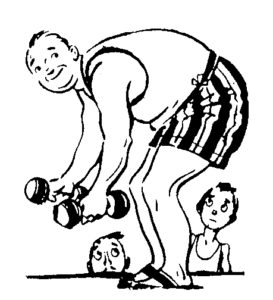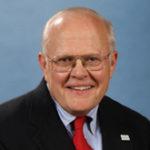 The following story, which I wrote for the Charlotte Observer and The News & Observer of Raleigh, originally appeared in those papers on January 10. It appears here in expanded form, with links.
The following story, which I wrote for the Charlotte Observer and The News & Observer of Raleigh, originally appeared in those papers on January 10. It appears here in expanded form, with links.
When Sidney Eagles Jr. went in for his annual physical a dozen years back, his physician reminded him that he was overweight, that his blood pressure was high, and that his cholesterol was up there as well. The reminders had become a perennial checkup ritual for Eagles, who at the time was 60 and Chief Judge of the N.C. Court of Appeals.
The annual ritual changed, though, when Eagles mentioned that he’d been short of breath recently. His doctor became alarmed, which in turn alarmed Eagles. A few days later he went to the hospital for some routine cardio tests and wound up having an operation to remove an aortic blockage. Eagles had never been big on exercise up to that point, but the event got his attention.
“I don’t have the willpower to [exercise] unless I’ve got some skin in the game,” says Eagles. With his skin literally in the game now, Eagles became devout, hitting the Rex Wellness Center three to four times a week. He still doesn’t like to exercise, but he can’t ignore the difference exercise has made in his life.

“I am — and this really sounds like braggadocio, but facts are facts — I think my balance is better and I know I’m stronger,” says Eagles, who is now 72 and in part-time practice with the Raleigh law firm Smith Moore Leatherwood. “I feel good almost all the time.”
In a state where 30 percent of all adults are considered obese and thus are at significantly higher risk of suffering a variety of maladies — from diabetes to a variety of cardiovascular-related problems — Eagles’ example is a model for the vast number of North Carolinians who have neither the inclination to exercise nor, in their minds at least, the time. Like Eagles, they don’t want to exercise, but they know they need to.
No time?
Think you don’t have the time to exercise? Can you find a half hour every day? That’s all you need to make a difference in your health, according to the National Institutes of Health. “Most adults need at least 30 minutes of moderate physical activity at least five days per week. Examples include walking briskly, mowing the lawn, dancing, swimming for recreation or bicycling.”
Those 30 minutes can come in bits and pieces scattered throughout your day.
“Start small,” suggests Kelly Roberts, wellness specialist with Carolinas Medical Center’s LiveWELL Carolinas program in Charlotte. “Take the stairs vs. the elevator — that’s five calories right there. “Get up from your desk as many times during the day as your job allows. Keep [walking] shoes under your desk: Even 10 minutes walking at lunch is better than nothing.”
Caveat: If you do the same thing at the same intensity level during those 30 minutes, you’ll only notice the health benefits for so long. “You either need to increase the intensity during those 30 minutes or extend the length of your workout,” says Logan Johnson, an instructor with the Rex Wellness Center in Raleigh.
“Otherwise,” he adds, “your body adapts and those same challenges are not enough.”
Four areas of focus
It’s also not enough to focus just on one area. Frequently, when people think of exercising to improve their health, they think of aerobic exercises, such as walking, bicycling or doing the treadmill. In fact, there are four areas you should concentrate on to improve your health:
- Strength training. Wellness experts suggest you consult one of their own before embarking on a strength training program. “You want to make sure you’re targeting the proper muscle groups, and that your form is good so you avoid injury,” says Johnson. A personal trainer can prescribe an appropriate workout program based on your time, needs and resources. (The cost of a personal training session varies. At Rex, non-wellness center members pay $45 for a half hour session, $65 for an hour session. The per session cost goes down if purchase multiple sessions.) Resistance training, using simple rubber bands available for $20 or less, is a popular home strength training option. Or, you can fashion an effective strength training program using your body weight for resistance. “The value of doing things with your own body weight” — wall sits, planks, curling a can of tomatoes — “can’t be underestimated,” says Roberts. “There are things you can do using three- and five-pound weights in the privacy of your own home while watching TV.” Exercises: For a rundown of resistance band exercises, visit About.com here.
- Flexibility. Stretching to improve your flexibility may be the easiest exercise to incorporate into your daily routine. For instance, the Mayo Clinic suggests seven quick stretches — shoulder stretch, upper arm stretch, chest stretch, chin tuck, head turn, side neck stretch, lower back stretch and standing thigh stretch — you can do at your desk. (See an instructional slide show here.)
- Balance. Of new clients, Rex’s Johnson says, “Where I find the greatest improvement is in their balance.” Strength training exercises can help improve balance, as can basic yoga poses. Exercises: To learn basic yoga poses, check out ABC-of-Yoga.com here.
- Aerobics. Walking may be the best elixir out there for improving your health. To make your walk really count, says Johnson, get your heart rate up to 75 to 80 percent of your age-predicted heart-rate maximum. To figure that out: Start with the number 220 and subtract your age. Multiply the resulting number by .75 (for 75 percent) or .80 (for 80 percent). For example, a 50-year-old person wishing to increase his or her heart rate to 75 percent would multiply 170 (220 minus 50) times .75 to come up with a target heart rate of 127.5 beats per minute. Take your pulse (your wrist or neck are the most common spots for an effective reading) for 15 seconds, then multiply by 4. To make sure that you walk regularly, Roberts is a big advocate of pedometers. “People who wear pedometers consistently are 27 percent more active during the day,” she says. Pay less attention to the actual mileage tally (pedometers are based on your average stride, which can vary considerably) and more on the number of steps you take. Shoot for 10,000 a day, Roberts says.
Payoff
Don’t expect results immediately, says Roberts. “We feel you should be feeling significant differences in within a couple weeks,” she says. “If you’re taking the stairs, for instance, within a couple weeks you shouldn’t be as winded.”
Give it another couple of weeks before really putting your new lifestyle to the test.
“After a month or so, go do something you haven’t been able to do in a while,” says Johnson. “I had one woman who began lifting a stack of plates over her head. She’d never been able to do that before.”
Again, he stresses that if you want to see continued progress you’ll need to increase either the intensity of your workout or work out longer.
Buddy up, muscle up
You’ve had a long day at work, you’re tired and — sniff! — is that a cold coming on? Maybe I’ll skip tonight’s workout, just this once.
And you likely will, unless a workout buddy is expecting you to show up.
“A support system is important,” says Logan Washburn, fitness director at UNC’s Meadowmont Wellness Center in Chapel Hill. “Someone to keep you accountable, whether it’s a trainer or someone who comes and works out with you.”
Studies have shown that people are more likely to remain true to an exercise program if there’s a little peer pressure, be it a workout buddy, a a group you train with, or simply a friend who likes to hear about your progress, and thus, someone you don’t want to let down.
“You’re not in this alone,” advises the Mayo Clinic in its “7 Tips for Staying Motivated.” “Work out with your partner or other loved ones. … Organize a group of neighbors to take fitness classes at a local health club.”
“If you’ve got a group environment for support,” agrees Washburn, “you tend to be more successful.”
Ultimate motivation
Non-exerciser Sidney Eagles Jr., who’s been exercising religiously for 12 years now, says the ultimate motivator for anyone in poor to marginal health is pretty simple:
“If you had been in my position and didn’t perceive it as a wake-up call, you’d either be foolish, slow or temperamentally doomed to be in trouble — soon.”
* * *
Like us on Facebook and get health, fitness and outdoors news throughout the day.

Enjoyed the article. Can you send me a link to the first in the series or tell me what the print date was.
Walter Lamb
welamb@gmail.com
You can find the entire series here … http://www.newsobserver.com/exercise/